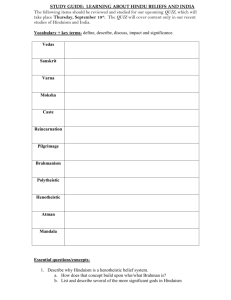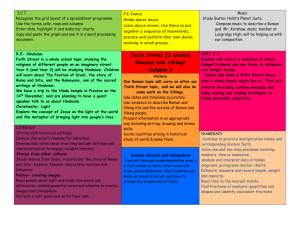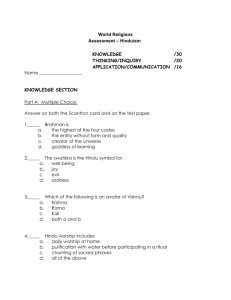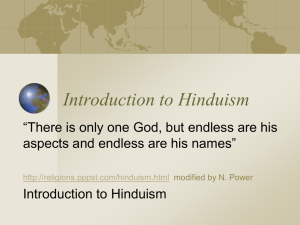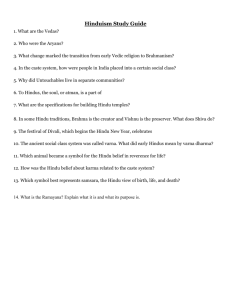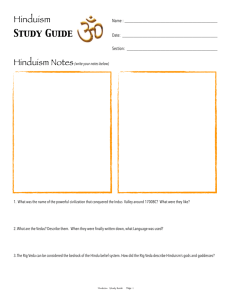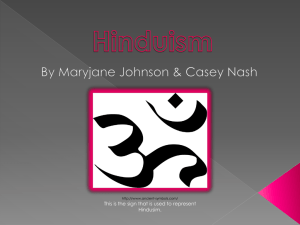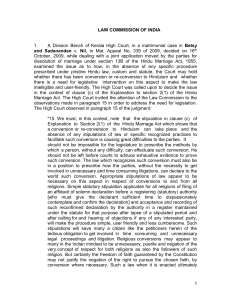Summary of Hinduism Beliefs - Bradley Baptist Association
advertisement
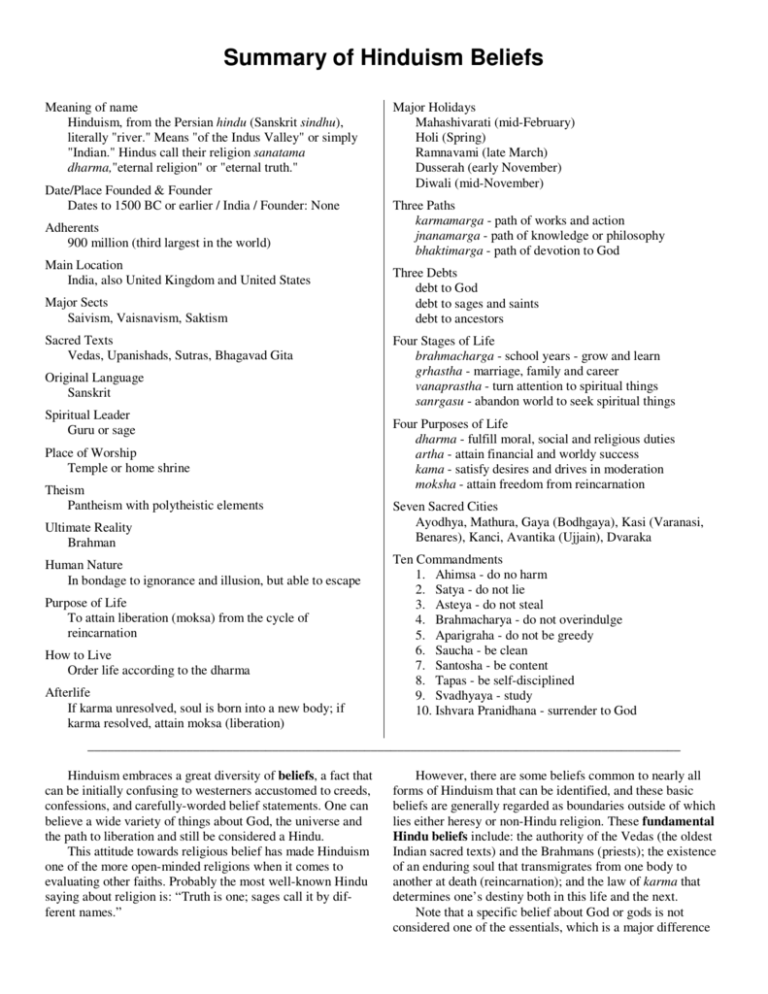
Summary of Hinduism Beliefs Meaning of name Hinduism, from the Persian hindu (Sanskrit sindhu), literally "river." Means "of the Indus Valley" or simply "Indian." Hindus call their religion sanatama dharma,"eternal religion" or "eternal truth." Date/Place Founded & Founder Dates to 1500 BC or earlier / India / Founder: None Adherents 900 million (third largest in the world) Main Location India, also United Kingdom and United States Major Sects Saivism, Vaisnavism, Saktism Sacred Texts Vedas, Upanishads, Sutras, Bhagavad Gita Original Language Sanskrit Spiritual Leader Guru or sage Place of Worship Temple or home shrine Theism Pantheism with polytheistic elements Ultimate Reality Brahman Human Nature In bondage to ignorance and illusion, but able to escape Purpose of Life To attain liberation (moksa) from the cycle of reincarnation How to Live Order life according to the dharma Afterlife If karma unresolved, soul is born into a new body; if karma resolved, attain moksa (liberation) Major Holidays Mahashivarati (mid-February) Holi (Spring) Ramnavami (late March) Dusserah (early November) Diwali (mid-November) Three Paths karmamarga - path of works and action jnanamarga - path of knowledge or philosophy bhaktimarga - path of devotion to God Three Debts debt to God debt to sages and saints debt to ancestors Four Stages of Life brahmacharga - school years - grow and learn grhastha - marriage, family and career vanaprastha - turn attention to spiritual things sanrgasu - abandon world to seek spiritual things Four Purposes of Life dharma - fulfill moral, social and religious duties artha - attain financial and worldy success kama - satisfy desires and drives in moderation moksha - attain freedom from reincarnation Seven Sacred Cities Ayodhya, Mathura, Gaya (Bodhgaya), Kasi (Varanasi, Benares), Kanci, Avantika (Ujjain), Dvaraka Ten Commandments 1. Ahimsa - do no harm 2. Satya - do not lie 3. Asteya - do not steal 4. Brahmacharya - do not overindulge 5. Aparigraha - do not be greedy 6. Saucha - be clean 7. Santosha - be content 8. Tapas - be self-disciplined 9. Svadhyaya - study 10. Ishvara Pranidhana - surrender to God __________________________________________________________________________________________ Hinduism embraces a great diversity of beliefs, a fact that can be initially confusing to westerners accustomed to creeds, confessions, and carefully-worded belief statements. One can believe a wide variety of things about God, the universe and the path to liberation and still be considered a Hindu. This attitude towards religious belief has made Hinduism one of the more open-minded religions when it comes to evaluating other faiths. Probably the most well-known Hindu saying about religion is: “Truth is one; sages call it by different names.” However, there are some beliefs common to nearly all forms of Hinduism that can be identified, and these basic beliefs are generally regarded as boundaries outside of which lies either heresy or non-Hindu religion. These fundamental Hindu beliefs include: the authority of the Vedas (the oldest Indian sacred texts) and the Brahmans (priests); the existence of an enduring soul that transmigrates from one body to another at death (reincarnation); and the law of karma that determines one’s destiny both in this life and the next. Note that a specific belief about God or gods is not considered one of the essentials, which is a major difference between Hinduism and strictly monotheistic religions like Christianity, Judaism, Islam and Sikhism. Most Hindus are devoted followers of one of the principal gods Shiva, Vishnu or Shakti, and often others besides, yet all these are regarded as manifestations of a single Reality. The ultimate goal of all Hindus is release (moksha) from the cycle of rebirth (samsara). For those of a devotional bent, this means being in God’s presence, while those of a philosophical persuasion look forward to uniting with God as a drop of rain merges with the sea. Authority of the Vedas and Brahmans The authority of the ancient scriptures known as the Vedas, as well as that of the priests known as the Brahmans, are two concepts that are fundamental to Hinduism and differentiate the faith from Buddhism and Jainism. Brahman: Ultimate Reality Most Hindus venerate one or more deities, but regard these as manifestations of Ultimate Reality. So who, or what, is the Ultimate Reality that is behind the universe and all the gods? In the Rig Veda, it is referred to as “the One.” In the Purushasukta, it is given the name “Purusha,” and in the Upanishads it is called “Brahman,” “the One,” and several other names. Karma The Sanskirt word karma means “actions” and refers to the fundamental Hindu principle that one’s moral actions have unavoidable and automatic effects on one’s fortunes in this life and condition of rebirth in the next. Polytheism? Hinduism is a decidedly theistic religion, but it can be difficult to determine whether it is a polytheistic, pantheistic, or even monotheistic religion. Of course, this is chiefly a western question: the Indian mind is much more inclined to regard divergent views as complementary rather than competing. Purpose of Life In Hinduism, there is not just one purpose of human life, but four: Dharma (fulfilling one’s purpose), Artha (prosperity) Kama (desire, sexuality, enjoyment) and Moksha (enlightenment). Symbols A variety of Hindu symbols are used in art, sacred objects and ritual. They usually signify Hindu concepts, the attributes of deities, or the gods or goddesses themselves. This section explains the history, meaning and use of some common Hindu symbols. Om (also spelled Aum) is a Hindu sacred sound that is considered the greatest of all mantras. The syllable Om is composed of the three sounds a-u-m (in Sanskrit, the vowels a and u combine to become o) and the symbol’s threefold nature is central to its meaning. It represent several important triads: the three worlds (earth, atmosphere, and heaven), the three major Hindu gods (Brahma, Vishnu, and Siva), the three sacred Vedic scriptures (Rg, Yajur, and Sama). Thus Om mystically embodies the essence of the entire universe. This meaning is further deepened by the Indian philosophical belief that God first created sound and the universe arose from it. As the most sacred sound, Om is the root of the universe and everything that exists and it continues to hold everything together. Bindi. One of the most recognizable items in Hinduism is the bindi, a dot worn on women’s foreheads. It is a form of the tilak, a symbolic mark worn by many Hindu men and women, but has less religious connotations than other tilaks. Traditionally, the bindi is worn on the forehead of married Hindu women. It symbolizes female energy and is believed to protect women and their husbands. Bindis are traditionally a simple mark made with the paste of colored sandalwood, sindoor or turmeric. The bindi is most commonly a red dot made with vermilion. In addition, the bindi is a way of accentuating the third eye, the area between the eyebrows where attention is focused during meditation. Men and women often apply a tilak after a puja ritual or on other religious occasions as a way of invoking religious feelings, concentration and focus. Bindi styles often vary by the area of India in which they are worn. The linga or lingam (Sanskrit for “sym-bol”) is the symbol of the god Shiva and the form in which he is most commonly worshipped. The phallic symbol is the main object of worship in Shaivite temples and homes throughout India and the world. The linga is a simple stylized phallus that nearly always rests on pedestal of a stylized yoni, or female sex organ. Together, the linga and yoni represent the power of creative energy and fertility. Lingas range from temporary versions made of sandalwood paste or river clay for a particular rite to more elaborate ones of wood, precious gems, metal, or stone. There are precise rules of proportion to be followed for the height, width, and curvature of the top. Some lingas are topped with a cobra, symbolizing the kundalini chakra located at the base of the spine (in Kundalini Yoga). In the primary religious ritual of devotees of Shiva, the linga is honored with offerings of flowers, milk, pure water, fruit, leaves and rice. In Hinduism, the lotus (Sanskrit: padma) primarily represents beauty and nonattachment. The lotus is rooted in the mud but floats on the water without becoming wet or muddy. This symbolizes how one should live in the world in order to gain release from rebirth: without attachment to one’s surroundings. A similar meaning is given to the lotus symbol in Buddhism. The lotus is associated with several Hindu deities. Krishna is described as the “Lotus-Eyed One,” referring to his divine beauty. Brahma and Lakshmi, the deities of potence and wealth, are often seen with the lotus symbol. Other deities associated with the lotus include Vishnu and Sarasvati. The lotus is also a symbol for the centers of consciousness (chakras) in the body. • • • • The pratik (“emblem”) is the symbol of the Ananda Marga (“path of bliss”) movement, which was founded in India in 1955 and emphases social service along with yoga and meditation. The pratik symbol consists of the following elements: upward-pointing triangle, representing one’s external actions (social service) downward-pointing triangle, symbolizing one’s internal work (meditation, self-realization) rising sun, symbolizing spiritual progress through the balance of external and internal efforts swastika, representing fulfillment or one’s ultimate spiritual goal The swastika (Sanskrit svastika, “all is well”) is a cross with four arms of equal length, with the ends of each arm bent at a right angle. Sometimes dots are added between each arm. The swastika is an ancient symbol that has been found worldwide, but it is especially common in India. Its name comes the Sanskrit word svasti (sv = well; asti = is), meaning good fortune, luck and well-being. The swastika is most commonly used as a charm to bring good fortune (in which case the arms are bent clockwise), but it has a variety of religious meanings as well. The right-hand swastika is one of the 108 symbols of the god Vishnu as well as a symbol of the sun and of the sun god Surya. The left-hand swastika (called a sauvastika) usually represents the terrifying goddess Kali, night and magic. However, this form of the swastika is not “evil” and it is the form most commonly used in Buddhism. The auspicious symbol of the swastika is very commonly used in Hindu art, architecture and decoration. It can be seen on temples, houses, doorways, clothing, cars, and even cakes. It is usually a major part of the decoration for festivals and special ceremonies like weddings. The Nazis adopted the swastika because it was understood as an Aryan symbol indicating racial purity and superiority. (The Nazis propagated a historical theory in which the early Aryans of India were white invaders.) There may also be a connection with the swastika’s magical connections, for Hitler and other Nazi leaders were keenly interested in the occult. The tilak (Sanskrit tilaka, “mark”) is a mark made on a Hindu's forehead. On a man, the tilak takes the form of a line or lines and usually indicates his sectarian affiliation. On women, a tilak usually takes the form of a bindi dot, which has its own symbolism (see above). The tilak is worn every day by sadhus and pious householders, and on special occasions like weddings and religious rituals. A tilak is also applied by a priest during a visit to the temple as a sign of the deity's blessing, for both men and women (and western tourists, too). Tilak marks are applied by hand or with a metal stamp. They might be made of ash from a sacrificial fire, sandalwood paste, turmeric, cow dung, clay, charcoal, or red lead. In addition to its religious symbolism, the tilak has a cooling effect on the forehead and this can assist in concentration and meditation. Often a tilak is just a smear of paste, but other times it is more precise and elaborate. The followers of Shiva wear a tilak of three horizontal lines across the forehead, with or without a red dot. Sometimes a crescent moon or trident is included. The devotees of Shiva usually use sacred ashes (Bhasma) for the tilak. Among the followers of Vishnu, the many tilak variations usually include two or more vertical lines resembling the letter U, which symbolizes the foot of Vishnu. There is sometimes a central line or dot. Most Vaishanative tilaks are made of sandalwood paste (Chandan). The worshippers of the goddess Devi or Shakti apply Kumkum, a red tumeric powder. The trihsula (also spelled trishul or trisula, Sanskrit for "three spear") is a trident spear that is the emblem of the god Shiva. The weapon symbolizes empire and the irresistible force of transcendental reality. The three prongs of the trishula represent Shiva's three aspects of: creator, preserver, and des-troyer, as well as the three shaktis (powers): will, action, and wisdom. The fearsome goddess Durga also brandishes a trishula in one of her seven hands. A yantra is a geometrical diagram representing the universe. It is used in Hindu worship and meditation, especially in Tantrism. A yantra is quite similar to a mandala, but a yantra is differ-ent in that it can be a three-dimensional object of worship as well as a twodimensional diagram. Like the mandala, the yantra symbolizes cosmogenic development, from the absolute in the center to the material world at the edges. Yantras often have a seed mantra inscribed on them, and they are considered the verbal equivalent of a mantra. A yantra is only created during a highly complex ritual in a purified and ritually consecrated place. A three-dimensional yantra is made of stone or metal plates and is imbued with the power of a deity. It is then meditated upon as the deity, and is used as an instrument for visions of the unseen. A yantra is also drawn on the site where a temple will be built. The best known yantra is the Sri Yantra or Sri Cakra, which is especially used in the Sri Kula tradition of Tantrism. It is made of nine intersecting isosceles triangles of different sizes: five "female" triangles pointing downwards to represent Shakti and four "male" triangles pointing upwards represent-ing Shiva. In the middle of the Sri Yantra is the power point (bindu), the highest, invisible, elusive center from which the entire figure and the cosmos expand. The triangles are enclosed by two rows of 8 and 16 petals, representing the lotus of creation and reproductive vital force. The broken lines of the outer frame denote the figure to be a sanctuary with four openings to the regions of the universe. The Sri Yantra is considered the visual equivalent of the Sri Vidya, a mantra of 15 syllables. Each syllable represents a goddess who is located within the Sri Yantra. From www.religionfacts.com/hinduism

